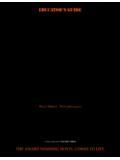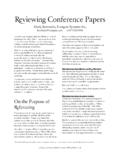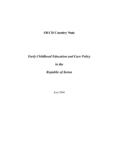Transcription of Textbook Reviews Secondary Economics - Rafe Champion
1 T LFT ::: Li . EDUCATIONRESOURCE CENTRES econdary EconomicsTextbook ReviewsTHE CENTRE FOREPENDENTSTUD I E SCONTENTS1 IntroductionTim Riley2 Ross Gittins,Gittins' guide to EconomicsandGarry Bell (ed.)The Australian Economy -A Student's guide to Current economic ConditionsReviewed byDr Robert Albon3 & Brown,Student EconomicsReviewedby Professor Geoffrey Brennan4 Gallagher & Burkhardt,Our economic Environment:An Introduction to the Australian EconomyReviewedby Professor Wolfgang & Shade,Foundations of EconomicsReviewed byDr Frank Milne 156 Shade, Latty, & Scott,Fundamentals of EconomicsReviewed byProfessor John Pincus 227 'Peter Joyce and Geoffrey Head,Our Kind ofEconomicsReviewedby Professor Clem Tisdell 258 Richard Morris,Speaking of Economics - The Australian SystemReviewed byDr Ian Wills 301369 VINTRODUCTIONTHESE seven Reviews of major high school Economics textbooks were commissioned by the CentreFor Independent Studies in 1989. A prime function of The Economics Education Resource Centreis to critically review the major books and other resources being used in the teaching of high schooleconomics in Australia.
2 Concern is widespread over the coverage and accuracy in the presentation ofmicro and macro Economics as well as the degree to which current textbooks motivate students to applytheir theoretical skills to current issues in the Australian textbooks represent a sample of those currently used in a number of mainland States. Sinceeconomics syllabuses vary from State to State, the demand for textbooks and their content tend to reflectthe particular State's syllabus requirements. However there are exceptions to this rule, as syllabus contentsconverge on common topics. In this case, a Textbook written in and for one State may appeal to teachersand students in other States, even if only for reference and supplementary reading of the texts such as Gallagher & Burkhardt'sOur economic Environmentand Brown'sStudent Economicshave been used in schools for over ten years and are now in their fifth and seventheditions respectively, whereas Miller & Shade'sFoundations of Economicsbroadly follows the WestAustralian syllabus, Joyce & Heads'OurKind of Economicsand Morris'Speaking of Economicsare moretailored to the Victorian Syllabus.
3 With the advent of the new NSW Economics Syllabus (introduced in Year11 in 1989) a host of new textbooks was ushered into the market (including updated versions of oldertexts). These were written according to the core and option approach adopted in Year 12 as well as thesectoral Circular Flow Model theme used in Year ; Latty, and Scott'sFundamentals of Economics Vol. 1is an update of Shade'sFundamentalsofEconomics. Gittins' guide to Economicsby Ross Gittins has the newspaper articles ordered to reflectthe new topic headings of the NSW Syllabus. There is a national trend towards the adoption of this core-option approach by syllabus committees and this has led to textbooks being written that have a very widecoverage of of these Reviews book's coverage of topics in breadth and in depth; of balance between micro and macro;and between descriptive and analytic accuracy of the exposition of traditional areas and new particular position taken by the book on controversial degree of emphasis placed on Australian institutions and the use of current book's suitability as an aid to the achievement of economic literacy, interest in Economics ,and as a basis for further study of the reviewers are all academic economists who tend to reflect the rigour of their teaching, particularly of undergraduates who may or may not have studied Economics at high school.
4 The Reviews are not allfavourable, though in many cases it is the course planners who are held responsible for designingsyllabuses that are out of date in terms of micro and macro theory, and fail to stress the application ofgeneral economic principles to current Australian economic issues. Many of the texts are written for thestudent who may simply memorise and rote learn information without necessarily grasping and applyingbasic economic concepts. This is perhaps a reflection of the emphasis placed on examination success atsenior school is perhaps a trade off between the wide and generally superficial coverage of topics in a courseand the importance placed by the reviewers on the development of analytical and critical thinking references like Alchian & Allen'sCompetition and Exchangeand Heyne'sThe economic Wayof Thinkingequip students with a theoretical base and present various interesting avenues for theapplication of this final common criticism seems to be the stubborn retention of Keynesian macroeconomic orthodoxy in the face of new developments in micro and macro theory.
5 The Monetarist, RationalExpectations and Supply Side schools are not given the prominence afforded them in the retards high school Economics and makes the transition from high school to tertiary1 THE EERC Secondary Economics Textbook Reviews Economics a rather difficult one for students. This volume is the first in a continuing series of Economics Textbook Reviews . The next volume willreview eight recently published textbooks, six of which were written for the new NSW Syllabus. has written an updated version ofStudent EconomicsentitledThe Australian Economy(with aworkbook) and Terry and Leonie Downing with Trevor Taylor have producedEconomics Towards 2000(an update ofEconomicsfor the EightiesBooks1 &2).Other titles to be reviewed include Jill Tuffley'sOurEconomyand the associated series of option books for the NSW 2 and 3 Unit courses; Barry Collier'sIntroducing Economics Books 1 John Paine et alEconomics for Australians Books 1, 2 Humphreys et alThe Economy. An Australian Focus Books 1& 2, Parry & Kemp's two books,ExploringMacroeconomics and Pathways in Economics ;and finally the very popular and widely used series byBulmer and Chapman calledUpdated EconomicsWhere applicable, workbooks are included in texts represent the revolution in writing that has occurred since the advent of the new approaches differ markedly.
6 Some are large and detailed volumes whilst others avoidundue wordiness by stressing basic principles and skills. The collection is competitive and offers teachersand students a welcome degree of choice in treatment, price and should live and be taught in such a way as to excite and motivate young minds to grapplewith contemporary problems by acquiring sophisticated analytical skills from well written RileySeries EditorDirector, EERCJune, RossGITTINsGittins' guide to EconomicsFirst Edition,VCTAP ublishing, Sydney, BELL (ed.)The Australian Economy -A Student's guide to Current economic ConditionsWarringal Publications, Melbourne, Dr Robert AltonSenior Lecturer in EconomicsAustralian National University, CanberraTHEG ittins' guide to Economics (GG) and the collection edited by Garry Bell,The AustralianEconomy: A Student's guide to Current economic Conditions 1988(SG)comprise an interestingset of journalistic economic writings, principally by Ross Gittins ofThe Sydney Morning first volume (published by the VCTA Publishing in 1988) is work totally by Gittins, while the secondcollection (from Warringal Publications) contains, in addition to three items by Gittins, pieces by PeterO'Hanlon and Barry collections are explicitly not `textbooks', but they are both intended for, in particular, secondaryschool students, with the intention of `bridging the gap between theory oriented and rapidly dating texts,and the ever changing world of Economics as applied to the Australian economy'(Gittins' guide ,Author'snote).
7 Scope, Balance and StyleTheGittins' Guideitself is broad ranging in scope with articles `arranged to fit with the EconomicsSyllabuses in several states'.The particular syllabus followed is not stated, but implicitly is a ratherlopsided one. In order of appearance the 45 items are grouped under the following headings: thehousehold sector, the firms sector, the financial sector, the government sector, the overseas sector,macroeconomic management; budgetary policy; monetarypolicy; incomes policy; external policy; laboureconomics; international Economics ; and the distribution of income and wealth. The bias is strongly infavour of macroeconomic topics; only six or seven of the papers are clearly microeconomic in other collection is also predominantly about macroeconomics with one of the five articles beingsolely about microeconomics and the other, four being almost exclusively about macroeconomics. Thedearth of microeconomics may reflect Gittins's training in the 1960s when macroeconomics was all the goin Australian articles are all written in a journalistic style - most of them come directly fromThe SydneyMorning Herald,while others were written for, or modified for, inclusion in these collections.
8 Theapproach is perhaps a bit too `chatty' in places, but this approach is the one that Ross Gittins has rathersuccessfully taken inThe Heraldover many years. Its appropriateness is, perhaps, a matter of taste, butIwould prefer a more serious manner for use in high ContentThe content of these volumes ranges from descriptive and institutional to theoretical. Where there is someanalysis, there is an emphasis on attempting to expound on difficult economic arguments in a clearcommonsense manner. The argument in Ross Gittins's articles is verbal throughout, except for one paper3 THE EERC Secondary Economics TEXTBOOKREVIEWS(GG-20 on therelationship between budget and current account deficits) where some symbols are Gittins proves himself overall to be a pretty good 'bush economist' but this level of analyticalcompetence is not always enough. Barry Streete (writing on the 'Accord') does not really chance his handat any analysis, and Peter O'Hanlon's article on interest rates, monetary policy and exchange rates is largelydescriptive, although it does have a small implicit theoretical where theoretical arguments are particularly well handled include the analysis of takeovers(GG-4); floating the dollar(GG-15)and the effect of asset sales on the budget deficit(GG-24).
9 Cases wherethere is some fuzziness in the analysis include the articles on business investment (GG-6),the aims ofmacro policy (GG-17)and tax disincentives and the supply of labour (GG-38). In other cases (discussedbelow) ideology and analysis seem to. get too closely and Descriptive ContentSome of the articles are purely institutional or descriptive ( not analytical) in nature, while others reporton published work. Like a good economic journalist should, Ross Gittins keeps abreast of publicationsfrom a variety of sources - official publications from government departments and bureaus, interestgroups ( the ACTU) and academics. Many articles revolve around recent publications and these are usually well synthesised for the reader. More explicit references to these publications would be a usefulinnovation in the guides, even if not in the newspaper descriptive and institutional material in many articles - particularly those in theStudent's Guideto Current economic Conditions-is very useful and up to date.
10 Statistics from a wide variety of sources are presented in a clear and competent manner, usually with the aid of graphs and tables. Institutionaldetails on matters such as wage fixing arrangements and the role of government in the determination ofexchange rates are accurate and ContentTurning now to the `ideological' content of these guides, one finds a rather mixed picture. The use of labelscan be misleading, but there are elements of many'isms' in these publications. Perhaps the strongest ofthese is `pragmatism', particularly as it might be applied to the policies of the Federal Labor Gittins would appear to be a fairly strong supporter of the approaches to economic policies of thesenior economic ministers - Keating, Walsh, Button, Kerin and Willis - all of whom have developedreputations for 'pragmatism' rather than adherence to 'ism' of prominence is that of Keynesianism in macroeconomic thinking. Gittins tells us that'I belong to the Order of Pump primers myself (GG-63) and this is clear from a number of the pieces whichextol the virtues of a rather crude brand of Keynesianism and/or are critical of an excessively crude strawman version of 'monetarism'.




